The content on your website has no value if nobody knows about it.
Creating helpful content is crucial, but it’s just one part of the SEO puzzle.
You need high-quality backlinks to enhance your content’s authority and rankings.
Especially if you want to rank for competitive phrases.
In this guide, we’ll cover everything you need to know about backlinking for SEO. By the end, you’ll know:
- What are backlinks?
- How backlinks and SEO go hand in hand?
- Powerful backlinking strategies to boost your site’s rankings?
Let’s dive right in.
What are Backlinks? And How to Build Them in 2024
What are Backlinks?
Backlinks are links that point from one domain to another domain. They’re also referred to as inbound or incoming links.
Here’s an example of a backlink from Legiit to HARO (Help A Reporter Out).

Web pages with high-quality backlinks tend to rank high on search engines. We’ll talk about what makes a backlink “high-quality” in a bit.
Let’s see why your Google rankings depend heavily on backlinks.
Why are Backlinks Important
Backlinks from websites other than yours are like neutral, third-party votes.
They tell Google that the content on your page is credible and helpful.
Backlinks build your authority, which translates into higher search rankings.
Links pointing to a website have always been an important Google ranking factor.
More importantly, backlinks will remain a core Google ranking factor in the future as well.
In addition to boosting authority, backlinks can help with:
- Traffic generation
- Brand building
Factors Affecting the Value of a Backlink
Every backlink is different in terms of SEO value.
A variety of things decide the power of a backlink.
Let’s discuss each briefly.
Authority
A single high-authority backlink is better than multiple low-quality ones.
Websites with a high authority transfer more authority with a backlink.
When pursuing backlinks, consider how authoritative the website is.
For instance, prefer a backlink from a government website instead of a random blog.
Backlinks that move the needle may be tough to get, but they’re worth the effort.
Anchor Text
The anchor text is the text that links one web page to another.
Here’s an example:

The phrase “Search engine rankings” is the anchor text that links this page to an external page.
When building links, including your target keyword in the anchor text can help you rank higher.
However, don’t use too many keyword-rich anchor texts as it can hurt your SEO.
Google has this algorithm “Penguin” that filters websites that overoptimize their anchor text.
Relevance
Backlinks from relevant websites carry more weight.
Let’s say you’ve published a blog post on dealing with depression.
A backlink from a digital marketing blog won’t have much value.
You want to build links from websites on similar topics like anxiety, stress, and exercise.
Dofollow vs. Nofollow
Every link has one of two HTML attributes:
- Dofollow
- Nofollow
The “Dofollow” attribute is the default one. It tells search engines to crawl and index the link.
Whereas, the “Nofollow” tag discourages search engines from associating the link to your site.
Here’s what a nofollow HTML tag looks like:

From the SEO perspective, the dofollow tag is more desirable as it passes link juice.
Most links on the internet are dofollow (or follow).
Nofollow links come from sources like:
- Paid advertisements
- Blog comments
However, your backlink profile may look unnatural if all of the links are dofollow.
This is why it’s a good idea to strike a good balance between both.
How to Build Backlinks in 2024
You can build backlinks through a variety of white hat, gray hat, and black hat methods.
We’ll only discuss the strategies that are safe, long-term, and effective.
Let’s dive in.
Create Linkable Assets
The first thing you want to do before even thinking about link-building outreach is create linkable assets.
It’s the best way to attract links organically.
Linkable assets include:
- Ultimate guides
- Videos
- Software
- Ebooks
It’s essentially anything that people would like to share with their audience.
For instance, we have an ultimate guide on hiring an SEO freelancer.

The blog post covers everything from how to hire a freelancer to a list of reliable service providers.
This makes it an ultimate resource for anyone looking to hire SEO freelancers.
Another type of linkable asset is a statistical roundup list.
These are articles with a list of statistical studies from reputable sources on a particular topic.
Statistical posts attract links like a magnet. Whenever someone uses a piece of statistic on your page, they’ll most likely link to it.
Original research is another linkable asset. Conducting research may be resource-intensive, but it can attract backlinks on autopilot.
You can also build backlinks by creating informative infographics.
An infographic visually represents information quickly and clearly.
It’s generally a combination of text, icons, graphs, illustrations, charts, and images.
You don’t have to be a designer to create a good-looking infographic.
Canva has a lot of pre-designed templates you can model according to your needs.
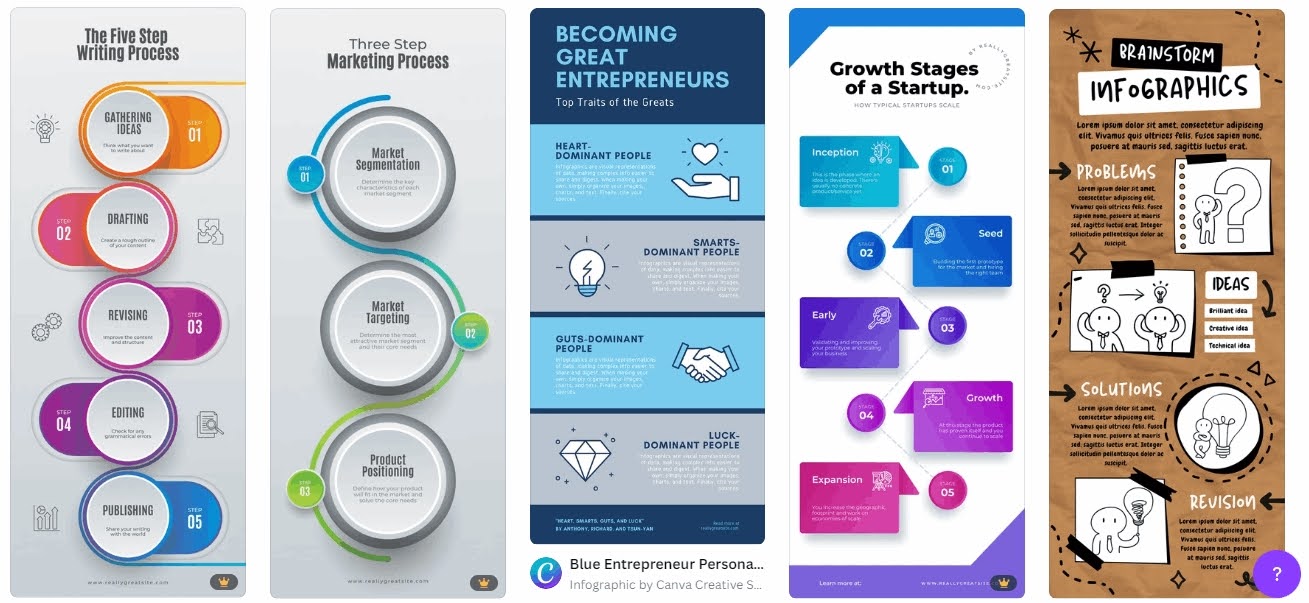
It has an easy drag-and-drop editor that allows anyone to create good-looking designs.
Alternatively, you can hire a freelance designer, like this one.
When it comes to creating linkable assets, the possibilities are endless.
Some more examples are:
- Excel and Google Sheets templates
- Cheatsheets
- Checklists
- Planning tools
The key to creating linkable assets is to identify the demand of your target market.
Use Link Roundups
Link roundups are pieces of content for the sole purpose of linking to quality content.
The cool thing is it’s the type of content you’re probably publishing on your blog already.
The key to a successful link roundup inclusion is:
- Finding relevant roundup posts
- Pitching your resource
To find these posts, you can use simple Google search operators like “Keyword + link roundup”.
Then, reach out to the owner of the post offering your resource as a suitable addition.
Use a professional email to send your pitch and gently ask them to add your link to the roundup.
Keep in mind that your post needs to be a perfect fit for the roundup.
If it is, you’ll get a high-quality backlink to your site.
Some other ways to find popular roundup posts in your industry are:
- Use Twitter’s advanced search
- Search your favorite blogs
- Use Buzzsumo
Leverage the Moving Man Method
The Moving Man Method is a painless way to build high-quality backlinks.
Here’s the step-by-step process:
Step 1: Find web pages or resources that have recently changed, moved, or are outdated.
Step 2: Identify websites that are still linking to those outdated/changed/moved pages.
Step 3: Let the website owner know they’re linking to the wrong resource. Offer your web page as the right alternative.
Let’s take an example. A while back, SEOMoz changed their branding to Moz and their website to Moz.com.
The old site had hundreds of links pointing to it, opening up a huge opportunity for link-builders.
Keep an Eye On Industry Blogs
Plenty of businesses change their branding and move to a new domain every day.
Keep an eye out for websites that change their name or move to a new URL in your industry.
Contact everyone linking to the outdated version and offer your resource.
Use Google Search
Some businesses, after discontinuing a service, don’t delete the web page.
They simply use a disclaimer like “This page doesn’t exist”.
You can find such pages with a simple Google search.
Some search strings are:
- Page no longer exists
- Website closed
- Service no longer available
- Service not available
- And maybe more
Once you find these outdated pages, start finding sites that are still linking to them.
You can do that by plugging the outdated URL into a backlink checker tool of your choice.
For instance, Semrush can give you a list of URLs pointing to that page.
Download the list as a spreadsheet. You now have a list of leads you can reach out to.
Broken Link-Building
Broken link-building and the Moving Man Method are similar.
But, as the name suggests, broken link-building focuses on pages that have the 404 error.
The process remains the same:
- Find broken links on web pages you want backlinks from
- Prepare or choose a suitable resource
- Reach out to the owner offering it as a replacement
The method works because broken links are bad for SEO.
And when you find them for a webmaster, you do most of the work for them.
As a result, it’s easier to convince them to replace it with your link.
You can use a variety of methods to find broken link opportunities.
One of the most effective ones is by researching resource pages in your niche.
You can find these pages with simple Google search operators like:
- “Keyword” + “Resource page”
- “Keyword” + “Resources”
- “Keyword” + “Links”
Resource pages tend to have a lot of links, so the chances of finding a broken one are high.
How do you find broken links on a resource page?
Use the free browser extension “Check My Links”.
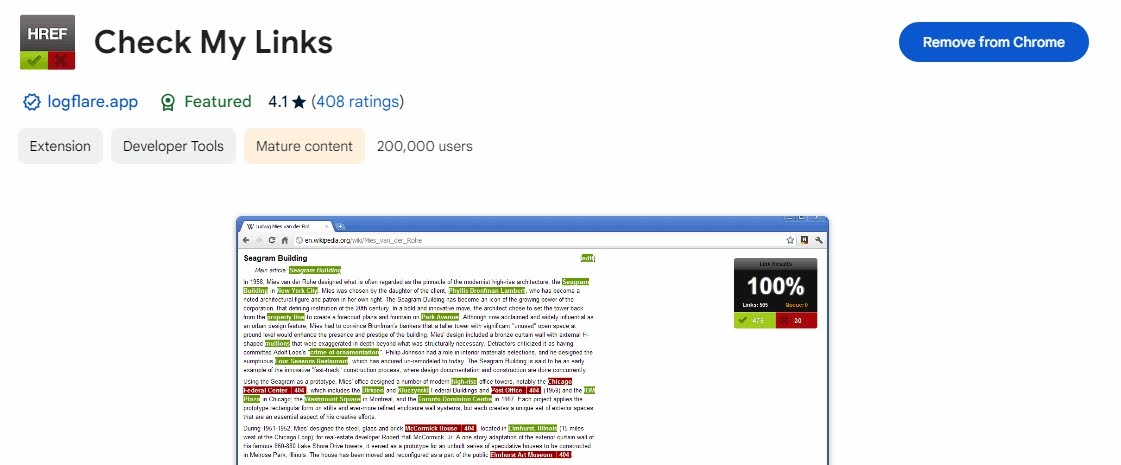
As soon as you find a broken link on a web page, find websites that are linking to it.
To do that, you can use an SEO tool like Semrush.
Just pop the broken link in the tool and it’ll give you a list of sites linking to it.
You’ll have a list of high-quality leads to reach out to.
All of these websites are linking to a broken link, which makes the outreach a lot easier.
Guest Posting
Despite what you might have heard, guest posting is far from dead.
In fact, it’s probably the safest way to build backlinks.
The strategy involves writing blog posts on other blogs as a guest writer.
What you get in return is a high-quality, relevant backlink to your site.
Guest post backlinks only help when they come from relevant websites.
For instance, a guest post on a tech website won’t help a mom blog.
To find the right guest posting opportunities, you can use Google.
Here are some search operators that will help:
- keyword “submit a guest post”
- keyword “accepting guest posts”
- keyword “guest post guidelines”
Just replace “Keyword” with your industry keyword.
Here’s an example:
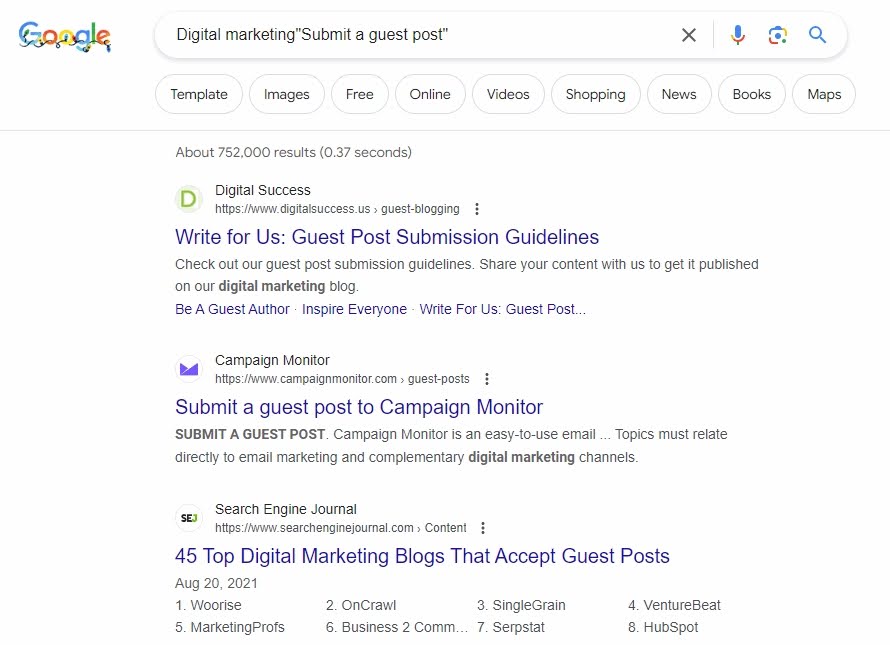
The “45 top digital marketing blogs that accept guest posts” will be a great place to find multiple opportunities.
Link Reclamation (Unlinked Brand Mentions)
Unfortunately, not all websites that mention you or your brand will link to you.
Fortunately, you can reach out to the owner of the blog and ask them to add your link.
It’s called link reclamation.
Since they’ve already mentioned you, persuading them to add your link will be easy.
In most cases, a gentle reminder is more than enough.
To find unlinked brand mentions, you can use a tool like BuzzSumo.
By doing that, you’ll get a notification every time someone mentions your brand.
As you get the notification, check to see if the brand mention also has a link to your site.
If not, send the owner a gentle reminder.
Use HARO

You can get super-high-authority backlinks from news sites with HARO, short for Help A Reporter Out.
HARO acts as a bridge between content creators or topic experts and journalists and news outlets.
Here’s how link-building with HARO works:
Step 1: Sign up as a “Source” on the official website here.
Step 2: Set your preferences by going to your account details.
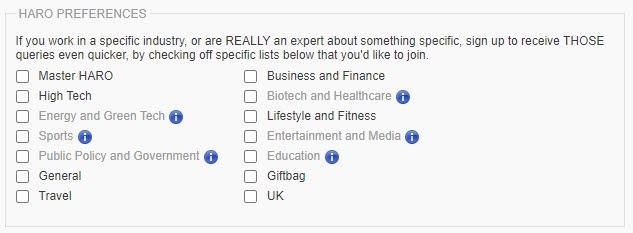
Step 3: Hit “Save and Update”.
You’ll now start receiving relevant queries in your inbox.
Step 4: Respond to relevant queries with helpful content and your credentials.
If you’ve signed up for “General” queries, here’s what the list will look like in your inbox:
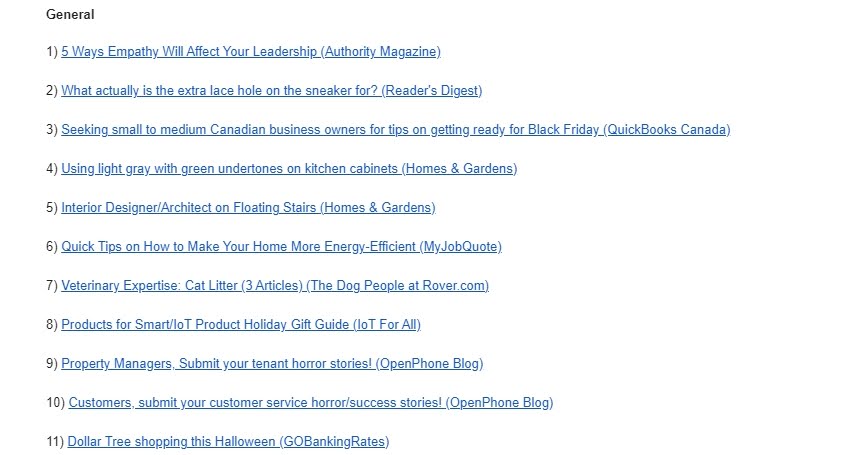
Clicking on each one of them will take you to its details.
Here’s an example:
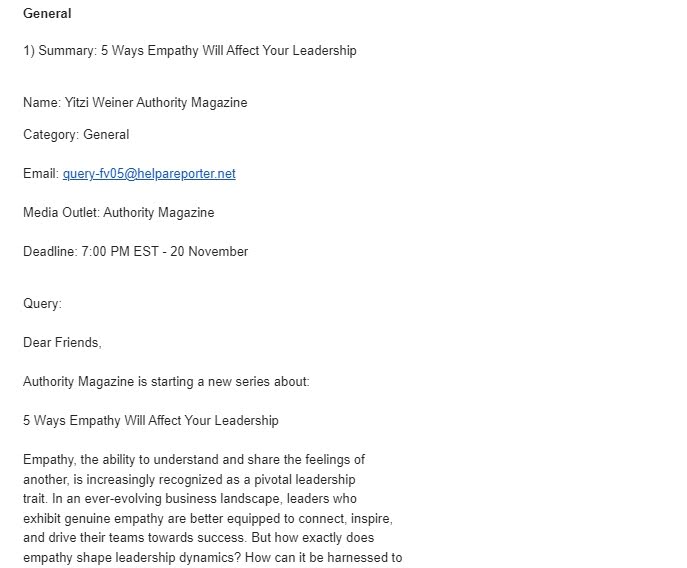
You can acquire backlinks from authoritative news sites with HARO.
But, making it work requires dedication and the right process.
Here are a few tips to help you succeed at HARO link-building.
Respond Quickly
HARO is a saturated platform for obvious reasons.
Freelancers and agencies are constantly trying to build quality backlinks from news sites.
As a result, standing out in the inbox of a journalist can be hard.
One way to improve your chances of getting noticed is by responding to the query quickly.
Journalists receive tons of responses to these queries.
And, as soon as they find the right one, they stop reading new responses.
So, even if your pitch is super valuable, if you respond late, the journalist may not even see your reply.
Choose Relevant Queries
Understanding what the journalist wants is the key to crafting a compelling HARO response.
Read the requirements thoroughly before writing your pitch.
Plus, only respond to the queries you think you’re qualified to answer.
Write Quality Pitches
Writing content journalists would want to use is key to getting high-authority backlinks with HARO.
Here are a few tips on creating compelling pitches:
- Add value
- Showcase your personality
- Keep it concise
The quality of your HARO response is the major factor in determining its success.
If your pitches are valuable, journalists will use them in their content. They’ll cite you as a source, providing you with quality backlinks.
Reverse-Engineer Competitors
Study your top competitors and learn what they’re doing for backlinks.
A simple backlink analysis in a tool like Semrush will give you the picture.
Reverse-engineering a competing website eliminates the guesswork.
You’ll know which backlinks will help you outrank that competitor.
Plus, it tells you what type of backlinks are worth pursuing in your industry.
For instance, a competitor may be using podcast backlinks to build authority.
Focus on What Works
When it comes to link-building, there’s no one answer.
For instance, infographics are great at attracting links organically.
But, they may not work for everyone.
This is where competitor analysis becomes so helpful.
You don’t have to do the testing yourself. Just keep an eye on your competitor’s strategies and cherry-pick what’s working for them.
Backlinks for SEO: Frequently Asked Questions
How Do I Get SEO Backlinks?
Creating linkable assets and sharing them with the right people is a powerful way to get SEO backlinks. Most strategies involve identifying the right websites and reaching out with an effective pitch.
What are Examples of Website Backlinks?
You can use a range of strategies to acquire website backlinks. A popular SEO backlink example is guest posting. Others are broken link-building, link reclamation, and HARO link-building.
What is a Backlink? How to Get More Backlinks?
So, what is backlinks in website? A backlink is an incoming link that connects your website with an external one. To get more backlinks, create assets people would want to share. Plus, be proactive in your approach and work on your outreach to get people to link to you.
Conclusion
There’s no denying that creating helpful content is crucial for SEO success.
But, it’s also true that backlinks enhance your content’s authority, which helps boost its rankings.
When it comes to link-building, you need a proactive approach.
Use different strategies to diversify your backlink profile. Some of the most effective ones are:
- Creating linkable assets
- Guest blogging
- Broken link-building
- HARO (Help A Reporter Out)
- Link reclamation
Understanding what’s working for your competitor can help you build backlinks that make a difference.


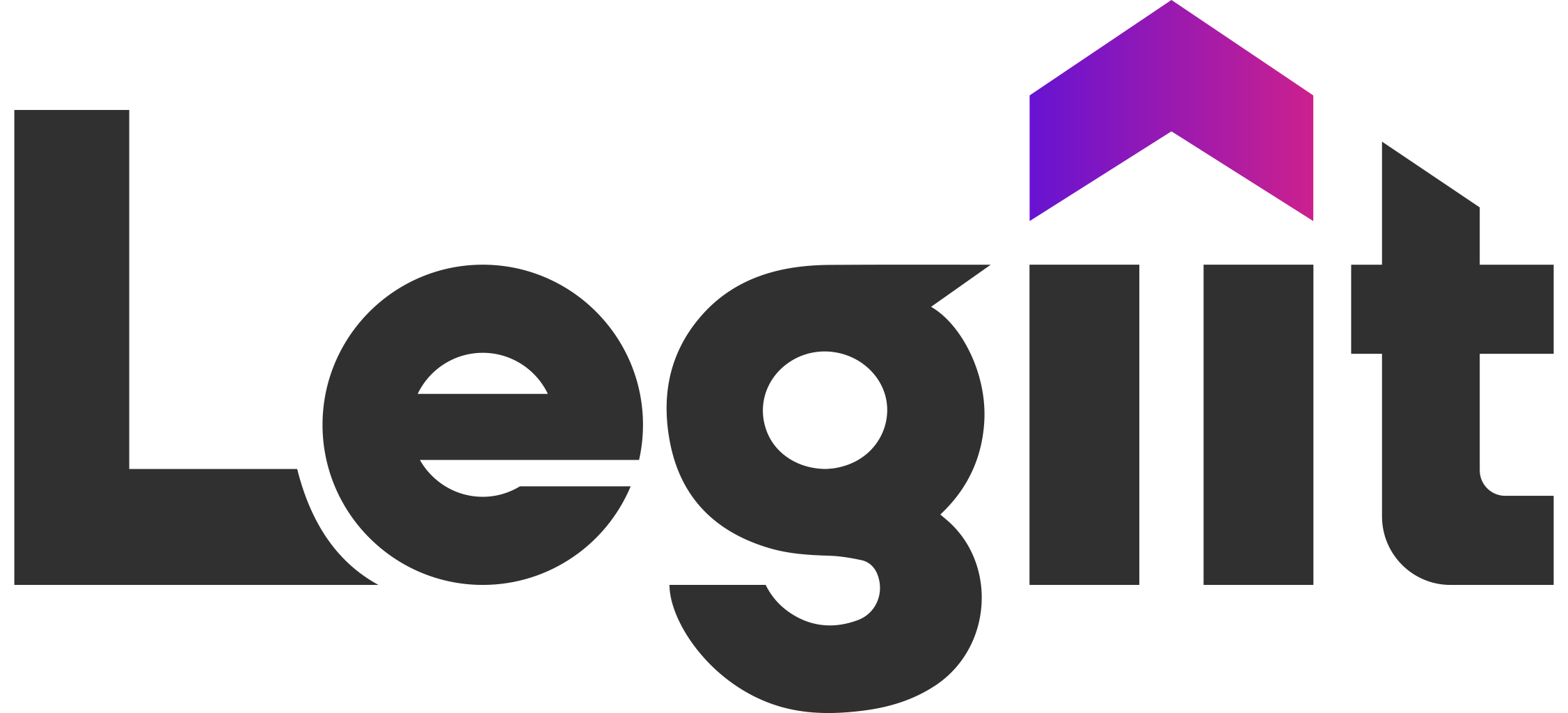











 Download
Download